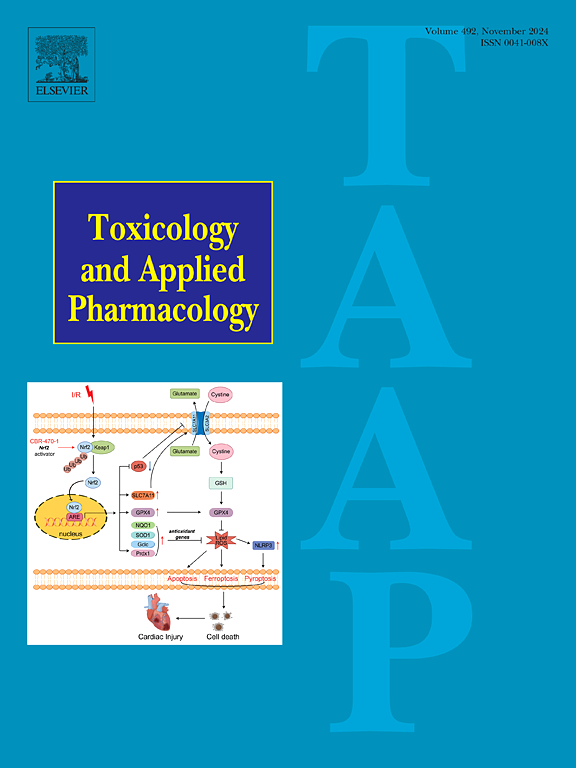Exploring the potential use of Caenorhabditis elegans as an animal model for evaluating chemical-induced intestinal dysfunction
IF 3.3
3区 医学
Q2 PHARMACOLOGY & PHARMACY
引用次数: 0
Abstract
Evaluating intestinal toxicity is crucial for identifying and preventing the harmful effects of environmental chemicals. Owing to the limitations of existing models in evaluating intestinal toxicity, the development of alternative models is urgently needed. This study explored the potential use of the nematode Caenorhabditis elegans as a model animal for assessing chemical-induced intestinal dysfunction. Changes in intestinal permeability and nutrient absorption in C. elegans individuals exposed to four intestine-disrupting chemicals (sodium dodecyl sulfate (SDS), dextran sulfate sodium (DSS), lipopolysaccharide (LPS) and ethanol) were examined using dye stain assays, an enzymatic photometric assay, and fluorescent probe uptake assays. Additionally, epigallocatechin-3-gallate (EGCG), an intestine-protecting phytochemical, was chosen to prevent ethanol-induced intestinal damage. The results indicated that SDS, DSS, LPS, and ethanol compromised the intestinal barrier in C. elegans. SDS had no effect on glucose absorption, but LPS, DSS, and ethanol inhibited or tended to inhibit glucose absorption. SDS, DSS, LPS, and ethanol reduced fatty acid absorption. LPS increased peptide absorption at a low dose but decreased it at a high dose; SDS, DSS, and ethanol attenuated peptide absorption. EGCG protected against the disruption of the intestinal barrier that was induced by ethanol treatment. These results suggest that C. elegans is a suitable surrogate model animal for evaluating chemical-induced intestinal dysfunction. These findings also provide new insights into the effects of SDS, DSS, LPS, and ethanol on intestinal function and highlight the potential of EGCG as a natural dietary intervention to protect individuals who use excess alcohol from intestinal injury.
探索将草履虫作为动物模型用于评估化学物质引起的肠道功能障碍的可能性。
评估肠道毒性对于识别和预防环境化学品的有害影响至关重要。由于现有模型在评估肠道毒性方面的局限性,迫切需要开发替代模型。本研究探讨了将线虫作为评估化学物质引起的肠道功能障碍的模型动物的可能性。研究采用染料染色法、酶光度测定法和荧光探针吸收测定法,检测了暴露于四种肠道干扰化学物质(十二烷基硫酸钠(SDS)、葡聚糖硫酸钠(DSS)、脂多糖(LPS)和乙醇)的秀丽隐杆线虫的肠道渗透性和营养吸收的变化。此外,还选择了一种保护肠道的植物化学物质表没食子儿茶素-3-棓酸盐(EGCG)来防止乙醇引起的肠道损伤。结果表明,SDS、DSS、LPS 和乙醇都会损害秀丽隐杆线虫的肠道屏障。SDS 对葡萄糖的吸收没有影响,但 LPS、DSS 和乙醇抑制或倾向于抑制葡萄糖的吸收。SDS、DSS、LPS 和乙醇减少了脂肪酸的吸收。LPS 在低剂量时会增加肽的吸收,但在高剂量时会减少肽的吸收;SDS、DSS 和乙醇会减少肽的吸收。EGCG可防止乙醇处理对肠屏障的破坏。这些结果表明,秀丽隐杆线虫是评估化学物质引起的肠道功能障碍的合适替代模型动物。这些发现还为了解 SDS、DSS、LPS 和乙醇对肠道功能的影响提供了新的视角,并凸显了 EGCG 作为一种天然膳食干预措施来保护过量饮酒者肠道免受损伤的潜力。
本文章由计算机程序翻译,如有差异,请以英文原文为准。
求助全文
约1分钟内获得全文
求助全文
来源期刊
CiteScore
6.80
自引率
2.60%
发文量
309
审稿时长
32 days
期刊介绍:
Toxicology and Applied Pharmacology publishes original scientific research of relevance to animals or humans pertaining to the action of chemicals, drugs, or chemically-defined natural products.
Regular articles address mechanistic approaches to physiological, pharmacologic, biochemical, cellular, or molecular understanding of toxicologic/pathologic lesions and to methods used to describe these responses. Safety Science articles address outstanding state-of-the-art preclinical and human translational characterization of drug and chemical safety employing cutting-edge science. Highly significant Regulatory Safety Science articles will also be considered in this category. Papers concerned with alternatives to the use of experimental animals are encouraged.
Short articles report on high impact studies of broad interest to readers of TAAP that would benefit from rapid publication. These articles should contain no more than a combined total of four figures and tables. Authors should include in their cover letter the justification for consideration of their manuscript as a short article.

 求助内容:
求助内容: 应助结果提醒方式:
应助结果提醒方式:


